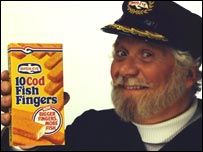St Kilda, Scotland
“It was horrible. We were forced to eat raw puffin for breakfast”
– Survivor on being trapped on St Kilda"
“Fffffffuuuuuuuuuuuuuuuuu....”
– Resident on falling off the Giant Cliff of St Kilda"
St Kilda (Scottish Gaelic: Hiort, or Scotland's Ayers Rock of the Sea) is the United Kingdom's only resident iceberg situated somewhere between the Western Isles of Scotland and possibly Canada or Iceland. The British Ordnance Survey have a great deal of trouble trying to locate this mountain of ice which floats about aimlessly within the Atlantic Ocean. This mountain at 1342 metres (13,574 feet) is only two metres smaller than Europe's tallest peak, Ben Nevis and is home to the tallest cliffs in the United Kingdom, and possibly the world.
Origin of Name[edit | edit source]
The iceberg was named after Saint Kilda (the Patron Saint of Scotland) whos boat Escape to Victory was reported to have crashed into it c. January 7th, 16AD. It is thought that St Kilda himself managed to survive on the island for three and a half weeks, surviving on rockhopper penguin delicacies with the aid of his trusty football named Mitre. Legend has it that he was then ripped to shreds by the world's deadliest bird, the bloodthirsty Atlantic Puffin of which millions now live on the island.
The alternative name of Hiort is also derived from the word Budhaig Hiortach which is the Gaelic for the Hiortian Puffin which itself was named after Hiort. The island is now also home to the Scottish Seabird Centre (which was relocated from North Berwick near Edinburgh to make it more accessible to the Scottish people), the Puffin World Heritage Centre, the Puffin Conservation Society HQ and the Puffin Dining Society.
Other Occupation[edit | edit source]
St Kilda has since been occupied by hunter gatherers who use the Atlantic Puffin as the centre piece of their staple diet. Technology over the years has improved vastly as a Tefal toaster and BBC Micro were introduced to the island only last week. Isolation was the predominant way of life and still is for the small number of prisoners that occupy the island today which has been used since 1997 as an alternative to a Stornoway Prison. Several inmates have attempted the long swim back to Hebrides, most of which have actually ended up in Norway after being swept away by the Gulf Stream. Geologists believe that St Kilda has been following this Gulf Stream for millions of years and that it is expected to collide with the Shetland Islands in 2046 ± 7.
During the 14th to 17th Centuries however, St Kilda was inhabited by Gaelic speaking communities. It is thought that the language was written and used first by St Kildinians before being introduced to the Western Isles after a bottle containing a letter was found on a beach by Iain Macleod of Barra in 1397. Several years later guring the Great War in 1918, The Others (who actually turned out to be the Royal Navy) turned up to plant a signal station and tracking device, originally believing that there was possibly a German U-Boat hidden inside. This turned out to be a misjudgement by MI5 intelligence as the U-Boat was actually disguised as the island Rockall which eventually sunk the H.M.S Hood in 1941.
The island is now empty as it was evacuated in 1930 by Stornoway Coastguard after local residents attached a mayday alert to the leg of a carrier puffin. When the message was received on Lewis and the Sea King helicopter finally arrived, the surviving population was discovered huddled together on a 12x4m drifting raft of melting ice 135 miles north west of Lewis. It is believed that during the warm summer of 1930, the St Kildan iceberg of Hirta had been slowly melting which shrunk the island. 1360 of the 1423 inhabitants perished in the icy cold waters that fateful day nowadays known as the St Kilda Disaster which recently ranked 2nd in UNICEF's Top 50 Humanitarian Disasters of the 20th Century (lagging just behind the building of Cumbernauld).
Conflicting Claims[edit | edit source]

Although formerly a self-governing British Crown dependency (similar to the Isle of Man and United States of America), St Kilda has been claimed by the United Kingdom just like most places around the world under the 'United Nations We Were Here First Convention'. Ireland, Iceland, Denmark (due to Faroese territories) and Senegal (just looking for a fight really) have all claimed their rights to the iceberg but with little success. The Danish also claim that the iceberg was originally part of the Arctic icesheet of Greenland giving them 'double the right' to claim this land.
This led to the brief St Kilda-Rockall War of 1982 in which Denmark thought that they would invade St Kilda whilst the British Navy were under-strength during the Falklands War. Unfortunately for the Danish, St Kilda had been brought into the Minch by the British who were anticipating an attack from the Argentinians at the time. St Kilda was then taken back to its original location by tug in August 1983 where it has remained since, although it drifted slightly over the Irish EEZ boundary in 1996 which led to political unrest and the resulting Manchester bombings by the IRA that same year.
In reality, nobody could care less about the land but all these countries are looking for is to extend their Exclusive Economic Zone (EEZ) to permit the exploration of oil and whaling (hence the interest from the Faroes). Oil exploration has taken place in the region, although all that came back from the surveys were some bits of paper covered in squiggly lines.
Disasters[edit | edit source]
There have been several disasters on St Kilda:
- 2005 - Sea storm brings down communications. Volunteers working on island over the summer are left without Big Brother for over two hours.
- 1996 - The Spice Girls' new debut album Spice arrives on the island.
- 1982 - St Kilda brought back into the Minch during Falklands conflict. Puffin colonies return to find their island have gone and are unable to fly back to Scottish shoreline before fatigue results in drowning. Over 150,000 puffins lose their lives.
- 1966 - St.Kilda Saints win their first and only premiership in 1.5 million years
- 1930 - The St Kilda Disaster. Earth reaches critical point in Milanković cycle eccentricity. Results in final evacuation and the tragic loss of over a thousand islanders after iceberg melts due to global warming.
- 1912 - The RMS Titanic collides with St Kilda on 14 April and dramatically sinks on 15 April. 1,517 people and a budgerigar parakeet perish in the accident. Captain Edward John Smith claims he collided with another iceberg in the Mid-Atlantic to cover up a navigational blunder.
- 1876 - The village rabbit falls over edge of the Giant Cliff of St Kilda. Entire population goes into three month period of mourning.
- 1588 - Entire crew of the Spanish ship La Cerveza is destroyed on rocks around San Kildo during their three day occupation of the island during the Spanish Armada invasion.
- 16AD - Saint Kilda sails his boat straight into some random and deserted un-named rock in the middle of the sea, prompting the Scottish Executive to cough up for a new lighthouse.
See Also[edit | edit source]
- Rockall
- Other Random Big Rocks in the Middle of the Sea
- St Kilda Aberdeen FC Supporters Club
- Aussie Rules Football Teams
- Sule Skerry Mermaid
- Na h-Eileanan Siar
- Puffin
RockallFuckall




